When you buy a house, you might think that you are in control of that house and its value. But in reality, your house’s value depends on a wide variety of factors beyond your control, such as the perceived desirability of your neighbors, local highway and transit policies, and trends in national and regional housing markets. Your home may be your castle in a physical sense- but its value is heavily affected by what goes on outside the residential setting. In her new book The Unbounded Home, University of Chicago law professor Lee Fennell addresses the implications of this reality and of homeowners’ attempts to reassert control over property values through restrictive covenants and zoning.
When you buy a house, you might think that you are in
control of that house and its value. But in reality, your house's value
depends on a wide variety of factors beyond your control, such as the
perceived desirability of your neighbors, local highway and transit
policies, and trends in national and regional housing markets. Your
home may be your castle in a physical sense- but its value is heavily
affected by what goes on outside the residential setting.
In her new book The Unbounded Home, University of Chicago law professor
Lee Fennell addresses the implications of this reality and of
homeowners' attempts to reassert control over property values through
restrictive covenants and zoning.
Covenants are usually designed to protect property values by excluding
certain obnoxious activities. Through covenants, homeowners contract to
give away some of their property rights in exchange for a veto power
over nearby homeowners' use of their property rights. Zoning, by
contrast, involves municipal ordinances rather than enforceable private
contracts.
But under either system, a city or group of homeowners must either
absolutely prohibit or absolutely allow certain activities. Fennell
points out that this approach often leads to inefficiencies- that is,
rules that create X amount of harm to one homeowner (or group of
homeowners) while creating less-than-X amount of benefit to others.
Fennell suggests a statue of a gnome as an example. Suppose Beasley
lives in a community that has banned yard art such as garden gnomes.
Gnome privileges will win Beasley $600 in intangible psychic benefits,
an amount in excess of the $500 cost the gnomes will impose on the
community as a whole. Fennell suggests that a more efficient system
would allow Beasley to install the gnome and compensate the community
for its "loss", thus resulting in a societal surplus of $100. However,
both zoning law and covenant law are not flexible enough to allow these
type of transactions.
Fennell suggests a variety of market-oriented solutions to the gnome
problem, and critiques each proposed solution. One simple option would
be to create fee schedules for rule violations; homeowners could pay for
the right to install gnomes. But a set fee schedule might be too
inflexible, or lead to definitional problems. Fennell proposes a more
complex but possibly more equitable solution: using self-assessed
valuations to set fees. Under this system, the homeowner would set the
value of his right to install gnomes, and the city or association would
have to either purchase his right or let him pay for the right.
At the end of the book, Fennell makes a broader attack on homeownership
as currently conceived. She asks: if a buyer of ice cream doesn't have
to buy a stake in the company, why should the buyer of a home have to
purchase the risk of national and international housing trends? The
current system forces homeowners to put nearly all of their capital in
one investment, thus creating economic catastrophe when house values
plummet.
As a remedy, Fennell proposes "Homeownership 2.0"- unbundling the
physical value of a home itself from the broader economic risks of the
housing market. Ideally, investors would create financial products that
would allow a homeowner to alienate some of those risks. For example,
an investor would sell a kind of insurance against declining property
values, promising to make up some of the difference between existing
values and a future price in exchange for an insurance premium. Or the
investor would bet on housing price premiums, buying the right to
receive part of a house's appreciation; the homeowner would benefit by
using the money to invest in more diversified holdings. But as Fennell
admits, there are "many [design issues] that would have to be confronted
in translating the H2.0 concept into a workable policy." So someone else will have to do the detail work of figuring out how to make Homeownership 2.0 profitable.

Planetizen Federal Action Tracker
A weekly monitor of how Trump’s orders and actions are impacting planners and planning in America.

Chicago’s Ghost Rails
Just beneath the surface of the modern city lie the remnants of its expansive early 20th-century streetcar system.

Amtrak Cutting Jobs, Funding to High-Speed Rail
The agency plans to cut 10 percent of its workforce and has confirmed it will not fund new high-speed rail projects.

Ohio Forces Data Centers to Prepay for Power
Utilities are calling on states to hold data center operators responsible for new energy demands to prevent leaving consumers on the hook for their bills.

MARTA CEO Steps Down Amid Citizenship Concerns
MARTA’s board announced Thursday that its chief, who is from Canada, is resigning due to questions about his immigration status.

Silicon Valley ‘Bike Superhighway’ Awarded $14M State Grant
A Caltrans grant brings the 10-mile Central Bikeway project connecting Santa Clara and East San Jose closer to fruition.
Urban Design for Planners 1: Software Tools
This six-course series explores essential urban design concepts using open source software and equips planners with the tools they need to participate fully in the urban design process.
Planning for Universal Design
Learn the tools for implementing Universal Design in planning regulations.
Caltrans
City of Fort Worth
Mpact (founded as Rail~Volution)
City of Camden Redevelopment Agency
City of Astoria
City of Portland
City of Laramie






























